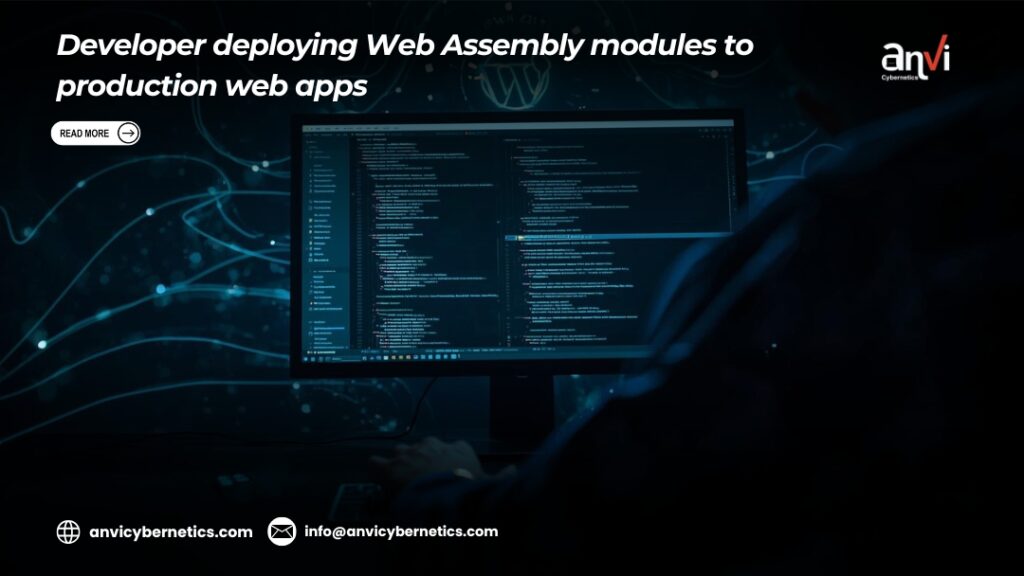
Web Assembly in Production: When to Compile, When Not To
Introduction
The web is changing — again.
From high-performance graphics to real-time AI inference, modern browsers now run workloads that once demanded native apps. The engine behind this leap is WebAssembly (WASM) — a low-level, binary instruction format designed for speed, portability, and safety.
Since its release, WebAssembly has grown from an experimental idea to a production-ready runtime powering products from Figma, AutoCAD, and Shopify to Cloudflare Workers.
Yet teams still ask the right question: When should we compile code to WebAssembly — and when is it overkill?
This post explores the technical, architectural, and business trade-offs of adopting WebAssembly in production.
What Exactly Is WebAssembly?
WebAssembly (WASM) is a binary format that runs inside a secure sandbox in the browser — or any environment that embeds the WASM runtime.
It allows languages like C, C++, Rust, Go, and AssemblyScript to compile into highly optimized modules that interact seamlessly with JavaScript.
Think of it as a portable assembly language for the web, designed to execute near-native code speed within a sandboxed environment.
Why WebAssembly Matters in Production
Performance isn’t the only motivator — it’s about unlocking new use cases for the web.
Governance models — pick what fits
1. When Performance Is Mission-Critical
If an application performs heavy computation, like physics simulations, encryption, or AI inference, WASM can dramatically reduce runtime.
Example:
2. When You Need to Reuse Existing Native Code
Many enterprises have decades of C++ libraries for math, finance, or data visualization. Rewriting those in JavaScript is costly.
WebAssembly allows you to recompile existing codebases for the web while preserving core logic — accelerating development and reducing risk.
3. When You Need Consistent Performance Across Devices
Unlike JavaScript, which depends on the browser’s JIT engine, WASM uses predictable compilation. This results in consistent performance between Chrome, Safari, Edge, and Firefox — critical for B2B or industrial web apps.
4. When You Need Secure Sandboxed Execution
For embedded logic, plugins, or untrusted third-party extensions, WASM offers isolation and limited access to the host environment.
Platforms like Shopify Functions use WASM to run merchant-defined business logic safely at scale.
5. When You Target Edge or Serverless Environments
WebAssembly isn’t just for browsers anymore.
Frameworks like WASI (WebAssembly System Interface) enable WASM to run on servers and edge networks with near-instant cold-start times.
Examples include:
If low-latency global delivery is your priority, compiling server logic to WASM can outperform container-based functions.
When Not to Compile to WebAssembly
WebAssembly isn’t a silver bullet. Use it strategically.
1. When Your App Is Mostly UI or DOM-Driven
WASM can’t directly manipulate the DOM. It must go through JavaScript, adding overhead. For apps dominated by UI interactions, vanilla JS or frameworks like React and Vue are often faster and easier to maintain.
2. When Build Complexity Outweighs Performance Gain
Compiling to WASM introduces toolchains (e.g., Emscripten, Rust toolchains), memory management, and debugging overhead.
If the speed-up is marginal, the maintenance cost may not justify the effort.
3. When You Need Rich Ecosystem Support
JavaScript’s npm ecosystem still far outpaces WebAssembly’s.
If you rely on frequent updates, third-party APIs, or browser-specific integrations, staying native to JS remains pragmatic.
4. When Binary Size Is a Concern
While WASM binaries are smaller than native executables, they can still add hundreds of kilobytes compared to minified JavaScript.
Large modules can increase initial page load unless cached aggressively.
5. When Developer Skills and Tooling Are Limited
WASM requires knowledge of memory management, bindings, and language-specific compilers.
If your team primarily works in JavaScript, learning Rust or C++ may slow down delivery in the short term.
The Hybrid Model: Best of Both Worlds
Many production systems adopt a hybrid architecture:
Examples include:
A financial dashboard may render charts with React but offload heavy statistical calculations to a Rust-based WASM module.
This approach balances performance and developer velocity without fully rewriting your app.
WASM Performance Optimization in Production
1. Reduce Overhead Between JS and WASM
Each call between JavaScript and WebAssembly introduces overhead.
Group related calls or batch data to minimize context-switching.
2. Optimize Memory Allocation
WASM memory is a linear buffer — manage it explicitly. Use language-specific allocators for efficient garbage collection.
3. Cache Binaries
Host pre-compiled .wasm files on CDNs. Modern browsers support streaming compilation, so large binaries can compile while downloading.
4. Use Web Workers
Run WASM in background threads to keep UIs smooth. Combine with SharedArrayBuffer for multi-threaded workloads.
5. Profile and Benchmark
Tools like Chrome DevTools Performance Panel or wasm-explorer can help identify CPU hotspots.
Security and Governance in Production
Sandboxing
WASM’s execution model isolates modules from the host system, preventing unauthorized access to OS APIs.
Memory Safety
WebAssembly enforces bounds-checked memory, eliminating buffer-overflow exploits.
Supply-Chain Integrity
Only load WASM binaries from trusted, signed sources.
Set Cross-Origin-Resource-Policy: same-origin headers and implement integrity hashes (<script integrity>).
Runtime Patching
Use feature flags to roll out WASM modules gradually, ensuring rollback paths for faulty deployments.
Emerging Ecosystem and Tooling
WebAssembly is evolving rapidly beyond browsers.
Here’s what’s shaping its next decade:
Governance and Monitoring in Enterprise Deployments
Real-World Case Studies
1. Figma
Migrated C++ rendering engine to WebAssembly → 3× performance improvement and instant browser startup.
2. Shopify Functions
Uses WASM to sandbox custom merchant logic, executing millions of isolated functions per second securely.
3. Cloudflare Workers
Executes WASM modules at 285+ edge locations, enabling sub-millisecond serverless responses.
Promotional Spotlight
Delivering high-performance web experiences today means choosing the right execution model for every component.
At Anvi Cybernetics, we help businesses modernize legacy architectures, deploy WebAssembly in production, and optimize hybrid JavaScript + WASM environments for speed, scalability, and compliance.
From compiler configuration to CI/CD automation, our experts ensure your app runs faster, safer, and smarter — anywhere.
👉 Explore our Web Development Services
Conclusion
WebAssembly isn’t replacing JavaScript — it’s redefining what the web can do.
In production, it shines where performance, security, and cross-language reuse matter most.
But not every feature needs compilation. The art lies in deciding when to compile — and when not to.
Use WASM for CPU-heavy tasks, sandboxed logic, or edge delivery. Stick to JavaScript for UI-centric or rapidly evolving features.
Get that balance right, and your web app gains native-like performance with web-grade agility — the best of both worlds.




